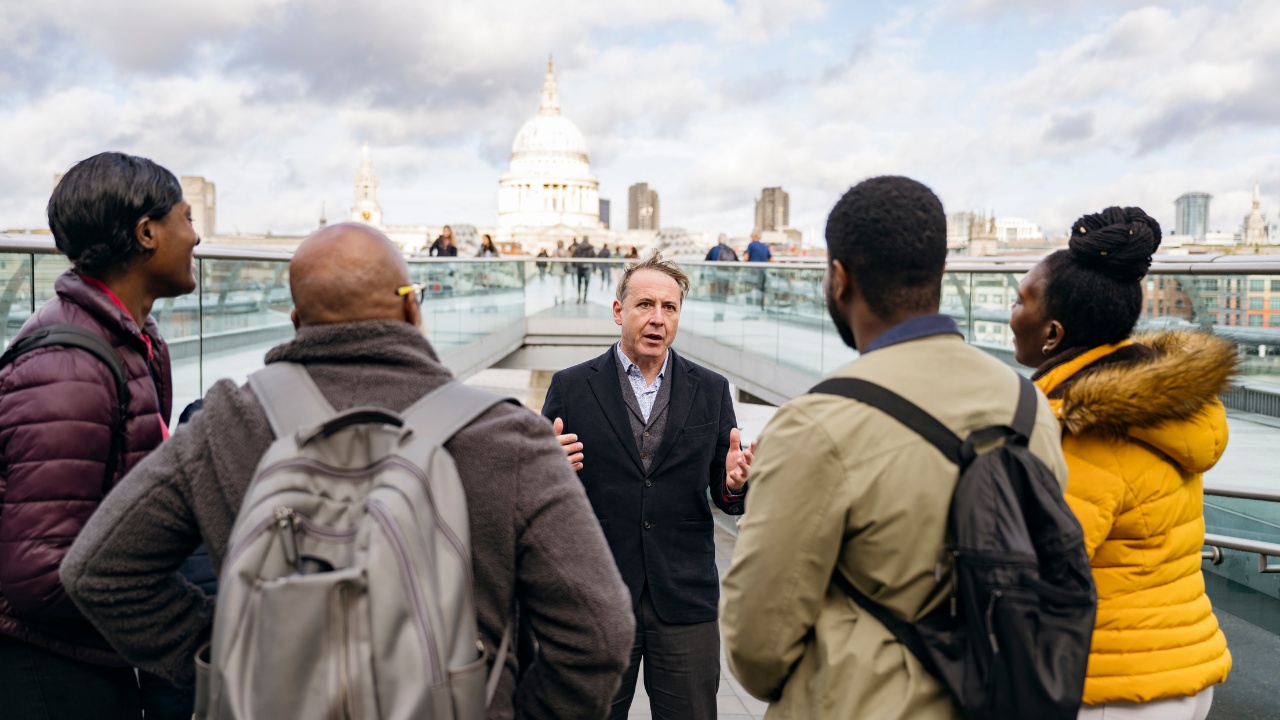As seasoned travelers know, the voice of a tour guide can transform mere sightseeing into a journey of discovery. Whether leading a walking tour through the historic streets of Boston or a virtual tour of the Canadian Rockies, a tour guide script is the invisible thread that weaves together historical facts, cultural insights and personal stories into a tapestry of unforgettable experiences.
At its core, tour guide scripting is about the art of storytelling. It’s the craft of bringing history to life, making the streets speak and the past breathe. A well-crafted script transports the audience through time and space, allowing them to see the world through new eyes.
Consider the difference between reading about the Liberty Bell in a guidebook and hearing its story told by a good tour guide. The guidebook may explain that it was rung to mark the reading of the Declaration of Independence, but an engaging guide will make you feel the tension in the air on that sweltering July day in 1776, the anticipation of the crowd gathered to hear the words that would change the course of history. This is the power of an expertly crafted tour guide script.

The basics of an effective tour guide script
Creating an engaging tour requires thorough research and a deep understanding of key facts. As a tour guide, you must be a walking encyclopedia of historical facts, data, and cultural nuances. But the real magic happens when you turn this wealth of information into great stories that resonate with your tour group.
To create your tour script, start by identifying the key points you want to convey about each historical site or topic. Then think about how to present those points in a way that tells a cohesive story. For instance, instead of simply stating that the Golden Gate Bridge was completed in 1937, you might say:
“Imagine San Francisco in 1937. The Great Depression is still gripping the nation, but something extraordinary is happening here. After four years of construction, battling fog, wind and the treacherous waters of the bay, the Golden Gate Bridge is about to open. As we stand here today, try to imagine the scene on opening day: 200,000 people, their spirits soaring at this marvel of engineering, walking across the bridge for the first time. The fog that usually shrouds the bay had lifted, as if even nature wanted to celebrate this great human achievement.”
This approach not only provides the historical fact, but also paints a vivid picture that ignites the imagination and emotions of your guests, enhancing their overall experience.

Crafting a compelling narrative
The structure of your tour guide script is critical to maintaining engagement throughout the tour. Think of your script as a story with a beginning, middle and end. Your intro should hook the audience and set the stage for what’s to come. As you move through different sites or topics on your tour itinerary, use transitions to maintain a sense of flow and cohesion.
For example, as you move from one historical period to another during a tour of Quebec City, you might say: “As we leave behind the echoes of New France, we’re about to enter the era of British rule. The fall of Quebec to British forces in 1759 didn’t just change the political landscape – it changed the very fabric of daily life in this fortified city, blending French and English cultures in ways we can still see and feel today.”
These transitions help maintain the narrative thread of your tour and prevent it from feeling like a disjointed series of facts and places.

The power of personal stories
One of the most effective ways to create an engaging tour is through the use of personal stories – both historical and contemporary. People connect with stories far more than with dry recitations of “facts,” so framing historical events through the experiences of individuals can make them more relatable.
When discussing the Underground Railroad, you could share the story of Harriet Tubman, who escaped slavery and then returned to the South several times to lead others to freedom. Her personal story of courage and determination can make the broader historical context of slavery and the fight for freedom more tangible and emotionally resonant for your tour group.
Similarly, don’t be afraid to include your own personal anecdotes or those of locals you’ve met. These stories can provide unique insights and add an element of authenticity to your tour guide’s commentary.

Customizing your script for different tour types
Even though the principles of good storytelling remain constant, different types of tours require different approaches to scripting. For one, it goes without saying that a walking tour provides a more interactive experience than an audio guide. You can incorporate the physical environment into your narrative, pointing out architectural details or hidden features that your group might otherwise miss.
Virtual tours, on the other hand, require a different set of skills. Without the ability to rely on the physical presence of historic sites, your script becomes even more important. You’ll need to be more descriptive, painting pictures with your words to help your audience visualize the scenes you’re describing. Incorporating high-quality visuals, interactive elements, and even sound effects can help create a more immersive experience.
The aforementioned audio guides present their own unique challenges. Your script must be clear and concise, providing historical information while giving precise directions to the listener. The pacing of an audio tour script is crucial – you need to give people time to take in their surroundings while keeping them engaged in your narrative.

The art of delivery
Even the best-written script can fall flat without effective delivery. As a tour guide, your voice, body language, and ability to make eye contact are all critical tools in bringing your script to life. For this reason, it is important to practice your delivery as much as possible, paying attention to your pacing, tone, and emphasis. Remember, you’re not just reciting information – you’re essentially acting!
Timing is also paramount. Know when to pause for effect, when to speed up to maintain excitement, and when to slow down to allow your group to absorb particularly important or complex information. Be prepared to adjust your presentation in real time based on your group’s reactions and energy.

Embracing the unexpected
While a well-prepared script is essential, the true art of guiding lies in the ability to adapt on the fly. No two tours are ever exactly the same, and the ability to read your audience and adjust accordingly is what separates good guides from great ones.
Perhaps you will find that your group is particularly interested in the indigenous history of the area. In that case, you can expand on those elements of your script, even if it means spending less time on other topics. Or maybe you have a group of architecture enthusiasts who are always asking about building styles. That is your cue to delve deeper into those aspects.
In short, your script should have built-in flexibility to handle these situations. Consider having a repertoire of additional anecdotes or facts that you can weave in as the opportunity arises. This adaptability will ensure that each tour feels fresh and tailored to your group’s specific interests, and may lead to unexpected twists that make the experience even more engaging.

The business side of tour guiding
Tour guides often focus on the art of storytelling- and rightly so -but it’s equally important to cultivate the business side of our craft. After all, your carefully honed tour guide script it’s a valuable asset that can elevate your entire operation.
Imagine sharing a particularly engaging anecdote from your tour on social media. That snippet of history could be the hook that draws in your next group of eager tourists. Platforms such as LinkedIn aren’t just for business networking; they’re perfect for showcasing your expertise and connecting with fellow history enthusiasts and potential clients alike.
When it comes to pricing, keep in mind that you’re not just selling a walk through the city, you’re offering a curated experience, a journey through time. Don’t be afraid to price your tours to reflect the value of your expertise and the uniqueness of your offering.
Last but not least, don’t be afraid to use the right technology. Booking systems like Checkfront can streamline your operations by efficiently handling reservations, payments, and customer communications. This allows you to focus more on creating engaging tours and less on administrative tasks. Leveraging these tools, you can build a business that is truly scalable and has the potential for long-term growth.

Continuous improvement and learning
The best guides never stop learning and honing their craft. That’s why, in addition to attending professional workshops to learn new storytelling techniques and industry best practices, we encourage you to stay abreast of the latest historical research and archaeological discoveries relevant to your tour areas.
It is also a good practice to solicit feedback from your tour groups and be open to constructive criticism. Pay attention to the parts of your tour that consistently get the most positive responses and think about how you can build on those strengths. Similarly, if you find that certain sections of your tour tend to lose people’s interest, consider how you might revise your script to make those sections more engaging.
The key is to recognize that your tour script is a living document. It should evolve and improve over time, reflecting both your growing knowledge and expertise and the changing interests and needs of your audience. Don’t be afraid to revisit and revise your first draft as you gain more experience and insight.

Conclusion
As we wrap up our exploration of tour guide scripting, let’s recap the key takeaways:
- Research thoroughly: Build a strong foundation of historical facts and cultural insights.
- Craft engaging narratives: Transform dry facts into compelling stories.
- Structure your script: Create a flowing narrative with a strong introduction and smooth transitions.
- Incorporate personal stories: Use anecdotes to make your tour relatable.
- Adapt to different tour types: Tailor your script for walking, virtual, and audio tours.
- Master delivery techniques: Use eye contact, body language, and vocal variety.
- Be flexible: Embrace unexpected twists and adapt in real time.
- Leverage technology: Use digital tools to enhance and promote your tours.
- Price strategically: Create unique experiences that justify premium pricing.
- Continuously improve: Refine your script based on feedback and new insights.
While you focus on perfecting your craft, let Checkfront handle the logistical aspects of your tour business. Our booking system streamlines reservations, optimizes pricing, and enhances the overall guest experience. Schedule a demo with us today and discover how we can help you turn your passion for storytelling into a thriving, well-organized tour business.

Take your business to the next level!
Online bookings. Flexible pricing. Outstanding support.



